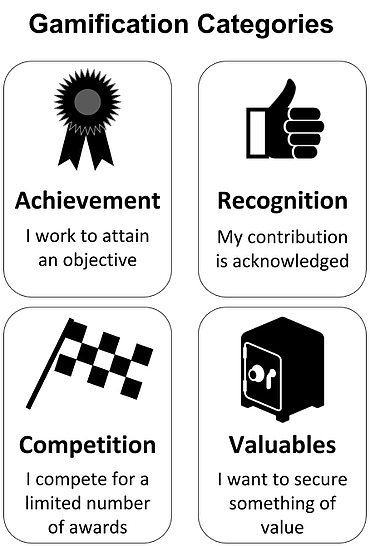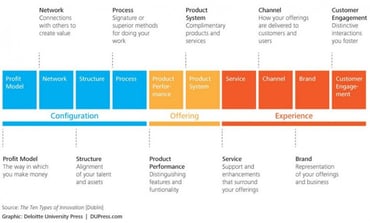Nature or nurture? The question is as old as the world. Are we born the way we are or are we raised to become the people we are today?
The same goes for the traits and skills we use at work. Do we come into this world with a special talent and ability to innovate better than others, or is it something we can all learn and acquire over time?
According to a study of 72 innovative entrepreneurs and 310 executives, the innovators demonstrated five key innovation skills consistently more than the regular executives. Perhaps surprisingly, four of the five skills are physical ones, and only one is cognitive, suggesting that it’s possible to take action to improve your ability to generate novel ideas.
So, when it comes to creativity, nurture rather than nature would seem to hold the cards. In his/her book “The Innovator’s DNA”, author Jeff Dyer explores the so-called "discovery skills" that we can learn to help us be innovative.
Let’s look at each skill.

1. Associating different ideas
Associating is the process of borrowing ideas from one area to use as inspiration in another.
Innovative entrepreneurs typically excel at putting themselves at the intersection of different disciplines.
Think of Steve Jobs taking calligraphy classes, then applying that knowledge to the fonts on the Apple Mac.
Or Ada Lovelace, arguably the world’s first computer programmer, who was just as comfortable with romantic poetry as she was with complex mathematics and algorithms. Her background in humanities helped her develop elegant solutions to enhance Charles Babbage’s famous Analytical Engine.
Marc Benioff wondered why all software wasn’t like Amazon or eBay. Why do we need cumbersome installation steps and internal IT management overheads to get a piece of software running? And so began the idea of Software as a Service (SaaS) for Customer Relation Management (CRM).
Design firm IDEO hires people who display the “T-shaped” characteristics of being a deep expert in one field while actively seeking out knowledge across a broad range of other fields. IDEO then creates teams with a diverse array of T-shaped skill sets. This collective diversity encourages and increases the number of "associated" ideas and the ability to view and solve problems from a very wide angle.
How to become better at associating
In his book “A Whole New Mind”, author Dan Pink suggests walking into a newsagent and randomly buying two or three magazines that are totally different to your typical genre. Read them, then see what connections and associations you can form to your area of work. Dan Pink explains that doing this regularly can help to build up your ability to associate between different subjects. I’ve tried it and it’s stimulating every time.
Ideas are like building blocks: The more ideas you have, the greater the chance of finding ways to combine them to create something entirely new. Innovators are like children in this respect; they love to collect ideas just like children love to collect and combine Lego bricks. Collecting as many ideas as you can, and from as many different sources, creates a solid foundation for innovating.
The more ideas you have, the better.
- The Innovator’s DNA
2. Never stop questioning
Research shows that innovative entrepreneurs engage in far more questioning than non-innovators. They probe by asking questions like “What if?” and “What is?”.
A.G. Lafley of P&G was famous for starting meetings with questions such as:
- Who is your target customer?
- What does she want?
- What kind of experience does she really want?
- What is missing today?
A few years ago, a study found that kids can ask their mothers around 300 questions a day, with the most prolific being four-year-old girls, who can ask up to 390 questions. As adults, we don’t come close to this veritable interrogation of the world around us.
But why?
There are two strong inhibitors:
- The fear of looking stupid.
- Not wanting to appear uncooperative or disagreeable.
But innovators are different. They are those children who grow up, but never learn to stop questioning, and never have the fear of questioning instilled into them.
Steve Jobs and Jeff Bezos have been known for their questioning abilities. When Jobs returned to Apple in the 90’s, he asked people to consider the question: ‘What would you do if money were no object?’
Questioning is the turbocharger for innovation and even if we’re not Jobs or Bezos, and we grew out of our child-like questioning frenzy years ago, we can all improve our ability to question.
How to become better at questioning
1. Use collaboration as a vehicle for questioning
Why not start by using collaboration functionality within your corporation’s innovation management platform as a turbocharger for questioning?
For any company, collaboration is the secret sauce for innovation, and raising questions as comments in idea management software can help to shape ideas into concepts more suitable for evaluation and further development. Commenting can also help to bring existing knowledge into the discussion to highlight existing ideas and the people with the right expertise to help.
HYPE Innovation has incorporated a “Multi-Perspective-Thinking” feature into its innovation management software to capture this concept. Based on the model of “Six Thinking Hats” by Edward de Bono, participants can flag their comments as representing a specific perspective, like “skeptic” or “creative”. Users can also ask for additional perspectives, to enrich ideas with specific viewpoints and achieve a more balanced idea.
The Multi-Perspective-Thinking feature helps users to gather innovative ideas from across their organization without having only top management engaged in the process.

2. Try out “question-storming” sessions
Run “question-storming” sessions as an individual or in a team by identifying a problem, then writing down at least 50 questions to ask about the problem. Don’t tolerate answers; only allow the discussion to focus on questions. Once you’ve listed all the questions, prioritize the most important ones, and then begin to look for solutions.
3. Translate statements into questions
Take something like company targets or a set of personal goals and reformulate them into questions. Doing so can help you understand the problem better and identify answers to help.
4. Track the question/answer ratio
Track your question/answer ratio: Across a variety of contexts (meetings, one-on-one discussions), track the number of questions you ask compared to the number of answers and comments you give. Seek to increase the ratio.
5. Keep a questions notebook
Log the questions you ask, and review periodically to see what types of questions work best (“What if? Why? Why not? How might?”). Richard Branson, who uses this technique, has notebooks full of questions.
Innovators of different kinds tend to ask more questions than their non-innovator counterparts.
- The Innovator’s DNA
3. Observing your customer
American entrepreneur and educator Steve Blank talks about the need for product managers to “get out of the building”, and by that, he means go and observe the customer in their environment and see what they see. There are no facts inside the building, only outside where the customer lives. This is the essence of the next skill: observing.
Chairman of the Tata Group Ratan Tata famously observed families in India dangerously riding together on a single scooter. He wondered how this could be made safer for families, at a reasonable cost? This inspired the Nano, the world's cheapest car.
Tata observed the job the customer was trying to get done, noticed how the current “product” was not fulfilling that job well enough, and tried to solve that problem.
Similarly, at IDEO, anthropologists are considered to be the single biggest source of innovation at the company, because anthropologists look deeply at how humans operate in their environment.
Observing the particular circumstances in which somebody “hires” a product for a “job to be done” creates a wealth of opportunities for innovation.
How to become better at observing
It’s common sense, but the reality is that most managers don’t get out of the building and intensely observe their customers. Consider scheduling regular excursions, even if just for half an hour, to observe what jobs customers are trying to get done. And look at companies and intensely observe how they work, what they do, how they get it done, treating it like a business school case study.
Google and P&G famously swapped employees for several weeks to see how they can learn from observing each other’s ways of working.
4. Networking for ideas
There are two types of networking skills.
The first, resource networking, is what people most often associate with “networking” and is what most executives are good at: selling themselves, their company, and their products to people who have the resources you seek.
The second, less-common type of networking skill is idea networking. Innovators excel at idea networking, seeking out diverse perspectives to gain fresh ways of seeing the world. They are not necessarily after resources; they are after perspectives.
Most executives are taught to be delivery-driven, in the sense that they are working toward company or career goals. So, for them, networking is about furthering those goals, by looking to sell what they have to people who have power, resources, and influence. This also means looking for people who are like them.
Innovators, on the other hand, tend to be discovery-driven, with the goal of finding people who sit in different social networks and possess knowledge they don’t have.
University of Chicago sociologist Ron Burt studied 673 managers in a large US firm and found that those managers who had broader connections with people who did not connect with other managers consistently had the most valued ideas.
Quite simply, get out of your existing network and form connections with as many other networks as you can.
How to improve your idea networking skills
1. Expand your network diversity
Make a list of the top 10 people you would choose to speak to about a new idea. How many of them have very different backgrounds to yours? How many are from another country? How many are under 20 years old and how many are over 75? The table below is an example you can complete.
2. Invite somebody new for breakfast or lunch
Following Keith Ferrazzi’s idea to Never Eat Alone.
3. Attend one or two conferences a year
On subjects completely unrelated to your field of expertise. TED is the ultimate experience, if you can get a ticket, and if you can’t, then watching the most popular talks online is a good alternative.
4. Start a creative community
Begin with just a few people who you trust to be open to new ideas and thinking. Meet up once a month to share ideas and discuss trends.
5. Experimenting
We see it time and again. Whether from Harvard Business School Professor Clayton Christensen himself, or from American entrepreneur Eric Ries and the Lean Startup movement, experimenting is absolutely critical for innovation success.
Jeff Bezos embodies the idea of experimentation:
Experiments are key to innovation because they rarely turn out as you expect, and you learn so much … I encourage our employees to go down blind alleys and experiment. We’ve tried to reduce the cost of doing experiments so that we can do more of them. If you can increase the number of experiments you try from a hundred to a thousand, you dramatically increase the number of innovations you produce.
- Jeff Bezos on Innovation.
Research shows that innovators show a far higher degree of experimentation skills than non-innovators. When combined with the skills of observing and questioning, this creates a potent mix.
If you've spent time watching your customers, understanding what task they need to perform, and posing questions about the circumstances and potential solutions, experimentation becomes a natural step to test those ideas.
Experiments help you gain insights, and each iteration of a build-measure-learn loop (The Lean Startup methodology) gets you closer to understanding the product/market fit.
But the more observing and questioning you do, the less you need to experiment to find the answer, because you’ve already generated significant insights upfront. However, if you do less observing and questioning, you simply need to run more experiments to gather the insights.
The bottom line is that if you ask salient questions, observe salient situations, and talk to more diverse people, you will likely need to run fewer experiments.
- The Innovator’s DNA
How to become better at experimenting
To develop skills in experimentation, you need to frequently approach scenarios with a hypothesis-testing mindset, asking what hypothesis you can test to help you learn something new about this problem.
So, there it is, the five skills innovators possess that set them apart from everybody else.
And the good news is that we can all improve our quota in each of them.









